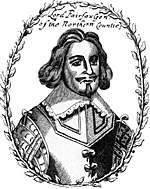
Apart from a minor skirmish at Bradford, [19] the First action of note in which Sir Thomas was involved did not represent a very auspicious
start. With 300 foot and 40 horse he was sent to hold Wetherby to keep open communications between his father's main forces at Tadcaster and their main area of support in the West Riding. Sir Thomas's own account of the attack made on Wetherby by Royalist forces is very illuminating.
"About six of the clock in the morning" (it was November and so still dark) "they set upon him witb 800 horse and foot. The woods tbereabouts favoured them so much as that our scouts could get no notice of them; so as no alarm was given 'till they were ready to enter the town, which they might soon do for the guards were all asleep in houses."
Fairfax goes on to tell us that when the alarm was raised he "galloped to the Court of Guard, where he found not above four men at their armes as I remember, two foot sergeants and two pikemen... " [20] Despite the failure of the guards this passage tells us that at least Sir Thomas knew what ought to be done to protect quarters in a town.
John Cruso, in his Militarie Instructions for the Cavall'rie says that scouts should be sent out to give advance warning of any advance of enemy troops. [21]. He also says that there should be sentinels or guards at the
entrances to a town with a central Corps-de-Guard, or Court of Guard, and that the guards should be provided by infantry when available. [22] All this
Fairfax had in place, but as he wrote, "in the beginning of the War, men were as impatient of duty as ignorant of it". [23]
His scouts didn't do their job properly, the guards were lax and the officers did not ensure that the measures to protect the quarters were properly carried out. In this Fairfax must take some of the responsibility. Cruso says that even the General should go around checking the sentries. [24] It was only the personal bravery of Fairfax and his four foot soldiers and, elsewhere, a Capt. Atkinson and some musketeers, that averted a disaster. [25] Fairfax had been lucky.
The next action fought by the Fairfax's Yorkshire army was the defence of the bridge at Tadcaster [26] but although Sir Thomas left us an account he played no part in what was an infantry fight and so we shall pass on to his raid on Sherburn at Elmet. John Wilson, in his biography of Fairfax, described this as "an almost perfect cavalry raid". [27]
He certainly took some important prisoners and captured some horses, but was it that perfect?
He undoubtedly got off to a good start. Cruso has very detailed advice on How to Assail a Quarter. [28]
He starts "A catain who is desirous to gain honour by some enterprise upon the enemy, though much his superior in strength, hath no better way than to assail him in his quarters". Well, the Fairfax's were certainly in need of some success against the greater strength of the Earl of Newcastle and both Sir Thomas and Capt. Hotham with whom he "resolved, early in the morning, to beat up a quarter of the enemy" were probably not averse to gaining some honour. [29]
Cruso continues to advise his captain "To effect this, be
must havegood knowledge of the village and the country thereabout
and if he can (by taking a little company) charge him on the reare or
on the flanks: if there be any negligence in the quarter, it is like to be
on those parts". Fairfax certainly knew the country well, his
family had extensive property in the area. Furthermore an account of
this action describes Fairfax as "fetching a compass, as if he
declined Sherburn: yet at last he wheeled about and assaulted the
town." [30]
Cruso also states "In the assailing of his quarter there are two things to be observed.
Touching the first, the first troop shall advance as secretly as may be: and as soon as they perceive themselves to be discovered shall charge the sentinels and enter the quarter with them, and surprise the Corps-de-Guard..."
Cruso then goes on to give details of the duties to be given to different troops to prevent the enemy from organising any sort of unified resistance. Curiously Cruso details the work of five troops, precisely the number accompanying Fairfax and Hotham. [31] Given that they had set out deliberately to beat up an enemy quarter is this just a coincidence?
More Fairfax
1. To make your approaches as near the village as possible may be.
2. To hinder him from uniting his troops into a bodie.
Sir Thomas Fairfax: Introduction
Sir Thomas Fairfax: Wetherby
Sir Thomas Fairfax: Sherburn
Sir Thomas Fairfax: Seacroft Moor and Wakefield
Sir Thomas Fairfax: Adwalton and Hull
Sir Thomas Fairfax: Winceby and Nantwich and Marston Moor
Sir Thomas Fairfax: Conclusion and Notes
Back to English Civil War Times No. 54 Table of Contents
Back to English Civil War Times List of Issues
Back to Master Magazine List
© Copyright 1998 by Partizan Press
This article appears in MagWeb (Magazine Web) on the Internet World Wide Web.
Other military history articles and gaming articles are available at http://www.magweb.com